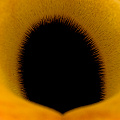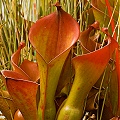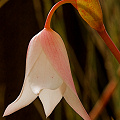Q: Heliamphora: the marsh (or sun) pitchers
A: Heliamphora is a beautiful genus of pitcher plants from
the Guiana Highlands of South America. There, the Heliamphora grow on (or near)
mountains, many of which are called tepuis. Temperatures on the tepui summits range between 8-20°C (46-68°F), with cold
but generally frostless nights. Rain is
nearly constant, with 200-400 cm (80-160 inches) annually. These chilly rains wash loose material
off the tepui-tops, so soil accumulation is rare. Because these tepuis are so geographically fragmented,
evolution travels different trajectories on each mountain, and each tepui may have its
own composition of unique species--33% of the tepui species occur nowhere else in the world!

H. nutans pitcher
It is common for people to think of Heliamphora as a genus of "primitive" pitcher plants,
and I think this is characterization is based on four tenets, which I think are unfair.
First, Heliamphora pitchers do
not have the large lids typical in other pitcher plants. This doesn't impress me, because the pitchers of
Heliamphora instead have a complicated little structure called a nectar roll (or nectar spoon) that varies from
species to species.
Second, Heliamphora pitchers apparently do not produce digestive enzymes. Well, neither does
Darlingtonia californica but no one calls that plant primitive! (There is some evidence
that Heliamphora tatei does produce its own enzymes.)
Third, for a long time photographs of
Heliamphora plants in the wild and in cultivation tended to show specimens that were all green, and not very
attractively pigmented. This made them look boring. Newer photography of plants in the wild show plants of spectacular
pigmentation patterns.
Finally, and very silly, people have long associated tepuis with
stories of "lost worlds", frozen in time and populated with dinosaurs. Heliamphora must therefore
be a primitive genus. Bah!

H. nutans
The name Heliamphora nutans was created by George Bentham for the first species discovered (by
Robert Schomburgk, in 1839). He intended the name "Heliamphora" to denote a
"marsh pitcher" (helos=marsh). However, the name has caused many to translate the genus
to "sun pitcher" (because helios=sun). But this strum und drang is all very silly, as
it is simply a common name of artificial construction, no matter how you slice it. I prefer saying
Heliamphora.
Heliamphora species forage using the basic pitfall strategy. Insects are attracted to the pitchers by their
colorful pigmentation and, in some cases, honeylike scent.
In particular, flying meals approach the nectar spoon at the top of the pitcher tube, attracted by the
generously productive nectar glands there. As they feed, they court death on the treacherous surface. Some lose the game. The inside
of the pitcher is adorned with downward pointing hairs (the exact nature and distribution of these hairs varies with the species), and
these hairs increase the efficiency of the pitcher's hunting skills. The bottom of the pitcher is filled with fluid, where the prey drowns.
Digestion occurs by bacterial action, although digestive enzymes may be produced by
at least Heliamphora tatei.
Heliamphora pitchers have marvelous adaptations to avoid being overfilled by the excessive rainfall on the
tepui-tops. The pitchers have a small pore or slit (depending upon the species) which acts as an overflow spout. No other
pitcher plant genus has this feature. Heliamphora species are primitive? Bah!
There is some conflict in the reports of the frequency of prey capture. Some field researchers report almost no prey in the pitchers,
while others observe plenty of captured prey. I can offer no reconciliation of these diverging reports!

H. heterodoxa × nutans
The flowers of Heliamphora are surprisingly monocot-like in appearance, and have four to six tepals.
There is a lot of controversy regarding the number of species in the genus, and the ranks for the various species. Should such-and-such
be a separate species, or only a variety, etc? There are, I think, three issues here which are causing problems. First, the tepuis have
simply not been sufficiently explored. They are hard to get to, hard to traverse, and permits to conduct research are
practically
impossible to obtain. So we have a hugely inadequate understanding of the plants that occur on the tepuis. Second,
simultaneously occurring processes of hybridization and speciation on fragmented tepuis have greated an ensemble of
Heliamphora populations that confound classification into distinct botanical taxa.
Third, different scientists have different definitions and perspectives as to what constitutes separate species. I do not position myself
as an expert on the genus---I have never been to South American and have never seen wild Heliamphora.
So I can only make my species lists based upon the arguments of scientists who have looked at the genus as a whole. I will be following the
system promoted by McPherson et al. (2011), which looks like it came from McPherson (2006), as influenced
by Berry et al. (2005). Although this system looks pretty good, the resulting species list is perhaps
a bit more splitted that I am completely comfortable with.
One thing is damned likely---my number of entries on my Heliamphora species list
will increase in the future!
Page citations: Berry, P., et al. 2005; Givnish, T.J. et al. 2000;
Jaffe, K., et al. 1992; Juniper, B.E., et al. 1989;
Lloyd, F.E. 1942; McPherson, S. 2006; McPherson, S., et al. 2011;
Nerz, J., et al. 2006; Rice, B. 2006a; Wistuba, A., et al. 2001.